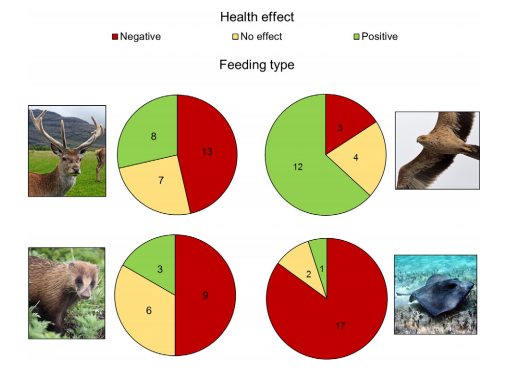 Humans provide supplemental food to wildlife under many contexts, ranging from professional feeding areas for game species to backyard bird feeders. Such resources benefit wildlife by providing reliable resources during periods of food shortages, but may also alter the risk of pathogen transmission and development of disease. This paper comprehensively quantifies support for mechanisms by which intentional wildlife feeding influences host condition (i.e. malnutrition and stress) and pathogen transmission on a global scale and provides a framework to mitigate these risks. Of 115 studies that evaluated the health of wildlife with supplementary feeding, the majority supported increased risk of pathogen transmission by increasing contact rates between hosts and promoting pathogen accumulation at feeders or the surrounding environment. Provisioned food was also often a source of immunosuppressive contaminants. Feeding associated with tourism frequently increased wildlife stress, rates of injury, pathogen prevalence, or malnutrition, while feeding for conservation purposes had mostly positive effects on wildlife health. This paper recommends adopting feeding practices that validate the nutritional appropriateness of wildlife feed for the target species, make food available at lower densities for short periods at unpredictable times and places to prevent aggregation, and avoid feeding during times of migration, pulses of new recruits, and epidemics.
Humans provide supplemental food to wildlife under many contexts, ranging from professional feeding areas for game species to backyard bird feeders. Such resources benefit wildlife by providing reliable resources during periods of food shortages, but may also alter the risk of pathogen transmission and development of disease. This paper comprehensively quantifies support for mechanisms by which intentional wildlife feeding influences host condition (i.e. malnutrition and stress) and pathogen transmission on a global scale and provides a framework to mitigate these risks. Of 115 studies that evaluated the health of wildlife with supplementary feeding, the majority supported increased risk of pathogen transmission by increasing contact rates between hosts and promoting pathogen accumulation at feeders or the surrounding environment. Provisioned food was also often a source of immunosuppressive contaminants. Feeding associated with tourism frequently increased wildlife stress, rates of injury, pathogen prevalence, or malnutrition, while feeding for conservation purposes had mostly positive effects on wildlife health. This paper recommends adopting feeding practices that validate the nutritional appropriateness of wildlife feed for the target species, make food available at lower densities for short periods at unpredictable times and places to prevent aggregation, and avoid feeding during times of migration, pulses of new recruits, and epidemics.
- Murray MH, Becker DJ, Hall RJ, Hernandez SM. 2016 Wildlife health and supplemental feeding: A review and management recommendations. Biological Conservation 204, Part B, 163–174. (doi:10.1016/j.biocon.2016.10.034)